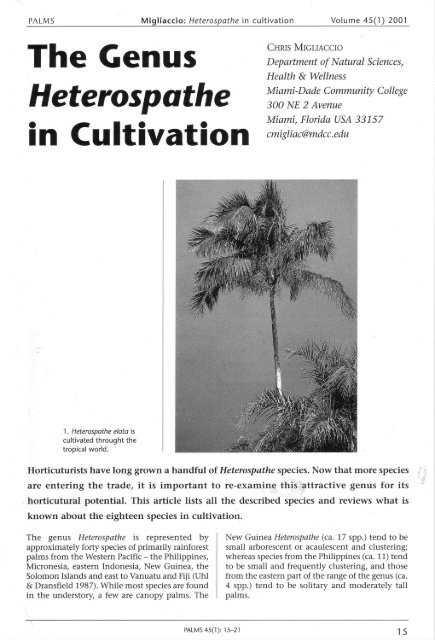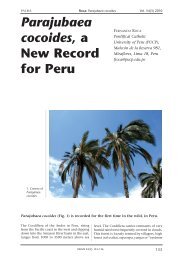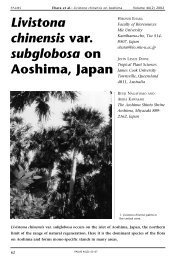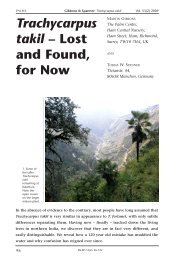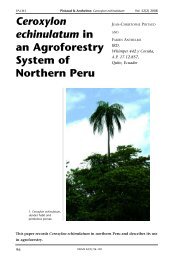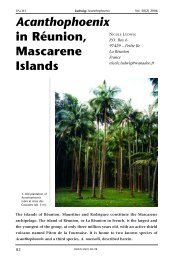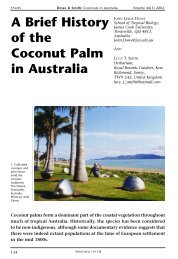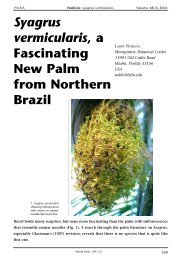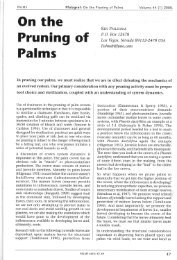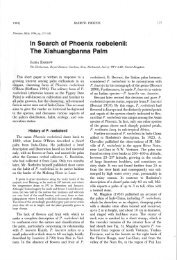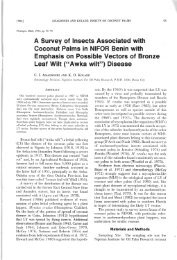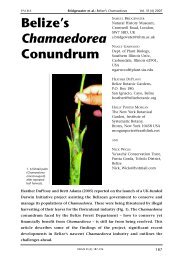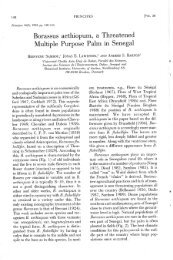The Genus Heterospsthe in Cultivation - International Palm Society
The Genus Heterospsthe in Cultivation - International Palm Society
The Genus Heterospsthe in Cultivation - International Palm Society
You also want an ePaper? Increase the reach of your titles
YUMPU automatically turns print PDFs into web optimized ePapers that Google loves.
PALMS<br />
Migfiaccio: Heterospathe <strong>in</strong> cultivation<br />
Volume 45(1) 2001<br />
<strong>The</strong> <strong>Genus</strong><br />
<strong>Heterospsthe</strong><br />
<strong>in</strong> <strong>Cultivation</strong><br />
Csnrs Mrcrrlccro<br />
Department of Natural Sciences,<br />
Health & Wellness<br />
Miami-Dade Community College<br />
300 NE 2 Avenue<br />
Miami, Florida USA 33157<br />
cmigliac@mdcc.edu<br />
'1. Heterospothelato is<br />
cultivated throught the<br />
tropical world.<br />
Horticuturists have long grown a handful of Heterospathe species. Now that more species<br />
are enter<strong>in</strong>g the trade, it is important to re-exam<strong>in</strong>e this attractive genus for its<br />
horticutural potential. This article lists all the described species and reviews what is<br />
known about the eighteen species <strong>in</strong> cultivation.<br />
<strong>The</strong> genus Heterospathe is represented by , New Gu<strong>in</strong>ea Heterospathe (ca. L7 spp.) tend to be<br />
approximatelyfortyspeciesof primarilyra<strong>in</strong>forest small arborescent or acaulescent and cluster<strong>in</strong>g;<br />
palms from the Western Pacific - the Philipp<strong>in</strong>es, whereas species from the Philipp<strong>in</strong>es (ca. 11) tend<br />
Micronesia, eastern Indonesia, New Gu<strong>in</strong>ea, the I to be small and frequently cluster<strong>in</strong>g, and those<br />
Solomon Islands and east to Vanuatu and Fiji (Uhl i from the eastern part of tfre range of the genus (ca.<br />
& Dransfield 1987). While most species are found 1<br />
+ spp.) tend to be solitary and moderately tall<br />
<strong>in</strong> the understory, a few are canopy palms. <strong>The</strong> i palms.<br />
PALMS 45(1): 15 21<br />
15
PALMS<br />
Migf iaccio: Heterospothe <strong>in</strong> cultivation<br />
Volume 45(1) 2O0<br />
However, very few of the other species have<br />
appeared <strong>in</strong> cultivation until recently. In the last<br />
few years, small but commercial quantities of seeds<br />
and nursery-grown seedl<strong>in</strong>gs of H. "brassii" (a<br />
nomem nudum with no botanical stand<strong>in</strong>g), H.<br />
brevicaulis, H. cagayanensis, H. deliculata, H. glauca,<br />
H. <strong>in</strong>termedia (Fig. 4), H. micrantha, H. m<strong>in</strong>or (Fig.<br />
5), H. negrosensis, H. phillipsii, H. philipp<strong>in</strong>ensis, H.<br />
sibuyanensis and H. woodfordiana have become<br />
readily available to growers. Because these species<br />
are "new to the trade" little is known about their<br />
cultural requirements. This paper, therefore,<br />
presents what is known at this time and identifies<br />
what may be some horticulturally valuable species<br />
worthy of greater use <strong>in</strong> the subtropical and<br />
tropical landscapes.<br />
A complete taxonomic review of Heterospathe<br />
would be particularly welcome <strong>in</strong> light of the<br />
current collect<strong>in</strong>g activity <strong>in</strong> New Gu<strong>in</strong>ea and the<br />
Solomon Islands (Fig. 6) that is expected to result<br />
<strong>in</strong> description of new species and clarification of<br />
the taxonomy of exist<strong>in</strong>g species.<br />
Species <strong>in</strong> <strong>Cultivation</strong><br />
<strong>The</strong> best known species <strong>in</strong> the genus is H. elata,<br />
the Sagisi <strong>Palm</strong>, which has been widely grown as<br />
2. Heterospothe solomonensis with unripe fruit. In<br />
cultivation<br />
Fairchild Tropical Garden, Miami, Florida.<br />
3. Heterospathe negrosensis, a 2o-year old specimen still<br />
without a trunk, Fairchild Tropical Carden, Miami, Florida<br />
<strong>The</strong>re are 41 validly published species <strong>in</strong> the genus<br />
but for many years, only a handful have ever been<br />
cultivated outside their native countries. Presently,<br />
about 18 taxa are known to be grown primarily by<br />
palm enthusiasts (Tab. 1). Warm and humid<br />
regions of Australia and Hawaii are well-suited for<br />
grow<strong>in</strong>g this genus. South Florida would probably<br />
support the species that are tolerant of alkal<strong>in</strong>e<br />
soils and occasional cold weather as long as the<br />
requisites of long-term conta<strong>in</strong>er culture, amended<br />
soils and cold, dry w<strong>in</strong>d protection are met.<br />
Southern California does not support any of the<br />
Heterospathe currently <strong>in</strong> cultivation (R. Rodolf &<br />
G. Ste<strong>in</strong>, pers. comm.) because of its long and cool<br />
w<strong>in</strong>ters. Some of the higher altitude species (J'I.<br />
delicatulq and H. humilis) perhaps could be grown<br />
there but these have not been available <strong>in</strong><br />
sufficient quantity for trials.<br />
For many years, Heterospathelata (Fig. 1-) has been<br />
the only widely cultivated species of this genusr<br />
particularly <strong>in</strong> South Florida. Occasional<br />
specimens of H. sibuyanensis, H. woodfordiana, H.<br />
elmeri, H. salomonensls (Fig. 2) and H. negrosensis<br />
(Fig. 3) have been sold at Fairchild Tropical Garden<br />
or South Florida Chapter of the IPS palm sales.<br />
16
PALMS<br />
Migliaccio: Heterospathe <strong>in</strong> cultivation Volume 45(1) 2001<br />
a landscape palm throughout the warmer<br />
subtropics and tropics. It produces prodigious<br />
numbers of seed that germ<strong>in</strong>ate on the ground<br />
under the parent or are carried away by birds and<br />
small mammals (Migliaccio, pers. obs.). In Guam,<br />
it is considered a weedy species and is crowd<strong>in</strong>g<br />
out native species <strong>in</strong> rav<strong>in</strong>es (|ones L995). Seeds<br />
germ<strong>in</strong>ate readily but take many years to develop<br />
a trunk, after which growth is rapid, particularly<br />
<strong>in</strong> full sun.<br />
Heterospathe<br />
"brassii" presents an <strong>in</strong>trigu<strong>in</strong>g case.<br />
Despite the fact that seeds of this taxon have been<br />
distributed by the <strong>Palm</strong> <strong>Society</strong> as early as 1988 (as<br />
88-PS-562), and that seedl<strong>in</strong>gs with this name are<br />
presently available from Hawaiian growers, the<br />
species ttame "brassii" has no valid taxonomic<br />
stand<strong>in</strong>g. That is, no species of Heterospathe has<br />
ever been formally described with this name so<br />
that its true identity is unknown. This name first<br />
appears <strong>in</strong> pr<strong>in</strong>t <strong>in</strong> an article written by the late<br />
Geoff Dennis <strong>in</strong> <strong>Palm</strong>s of the Solomon Islands (Dowe<br />
1989) without any descriptive <strong>in</strong>formation.<br />
Accord<strong>in</strong>gly, collectors should be wary of any<br />
plants identified as I{. "brassii." While germ<strong>in</strong>at<strong>in</strong>g<br />
readily, seedl<strong>in</strong>gs of this taxon have been prone<br />
to fungal <strong>in</strong>fection dur<strong>in</strong>g cool South Florida<br />
4. Heterospathe <strong>in</strong>termedio, l6-years old, <strong>in</strong> cultivation <strong>in</strong><br />
Luzon, Philipp<strong>in</strong>es (Photo by Carl Lewis).<br />
5. Heterospothe m<strong>in</strong>or, grow<strong>in</strong>g <strong>in</strong> the author's garden,<br />
has a colorful new leaf.<br />
w<strong>in</strong>ters and the few <strong>in</strong>dividuals planted <strong>in</strong> shady,<br />
protected locations <strong>in</strong> the alkal<strong>in</strong>e soils at Fairchild<br />
Tropical Garden have languished. This palm is<br />
reportedly native to the Solomon Islands.<br />
Heterospathe cagayanensis<br />
a variable species with<br />
acaulescent as well as 6 m tall, solitary trunked<br />
<strong>in</strong>dividuals. It has t<strong>in</strong>y seeds that germ<strong>in</strong>ate readily<br />
but are prone to damp<strong>in</strong>g off due to fungal<br />
<strong>in</strong>fection. Montgomery Botanical Center <strong>in</strong><br />
Miami, Florida has used weekly sprays of the<br />
systemic fungicide Phyton 29rM (Copper sulfate<br />
pentahydrate with 21,.360/o active <strong>in</strong>gredients) to<br />
prevent damp-off <strong>in</strong> Heterospathe. Treatment ends<br />
once seedl<strong>in</strong>gs are established (]udd, pers. comm).<br />
In Hawaii, this species has been shown to tolerate<br />
drought well once established (S<strong>in</strong>geo, pers.<br />
comm.).<br />
<strong>The</strong> dwarf species, H. deliculata, with its colorful<br />
<strong>in</strong>florescence, has outstand<strong>in</strong>g horticultural<br />
potential as a small conta<strong>in</strong>er palm (Essig, pers.<br />
comm.). In South Florida, it grows faster as a<br />
juvenile than H. elata and without any special<br />
cultural conditions (Searl, pers. comm.).<br />
Heterospathe salomonensis (Fig. 2.) from the<br />
Solomon Islands and the Philipp<strong>in</strong>e species, H.<br />
17
PALMS<br />
Migf iaccio: Heterospothe <strong>in</strong> cultivation Volume 45(1) 200<br />
Tab. 1. Heterospathe species <strong>in</strong> cultivation.<br />
Heterospathe species<br />
"brassii" (name not<br />
validly published)<br />
brevicaulis Fernando<br />
cagayanesis Becc.<br />
deliculata H.E. Moore<br />
elata Scheff.<br />
elmeri Becc.<br />
glauca (Scheff.) H. E.<br />
Moore<br />
humilis Becc.<br />
<strong>in</strong>termedia (Becc.)<br />
Fernando<br />
micrantha (Becc.) H. E.<br />
Moore<br />
m<strong>in</strong>or Bsrret<br />
negrosensis Becc.<br />
phillipsii Fuller & Dowe<br />
philipp<strong>in</strong>ensis Becc.<br />
salomonensis Becc.<br />
scituls Fernando<br />
sibuyanensis Becc.<br />
woodfordiana Becc.<br />
Native to<br />
Papua New Gu<strong>in</strong>ea;<br />
Solomon Islands<br />
Luzon, Philipp<strong>in</strong>es<br />
<strong>in</strong> lowland forests<br />
Luzon, Philipp<strong>in</strong>es<br />
SE Papua New Gu<strong>in</strong>ea acaulescent and prostrate; leaves to 1.8 m tall;<br />
at low to mid-elevations <strong>in</strong>florescence with purplish axis and flowers.<br />
(1100 m) <strong>in</strong> oak forests<br />
widespread <strong>in</strong> Philipp<strong>in</strong>es;<br />
Moluccas,<br />
Micronesia<br />
Camaqu<strong>in</strong>, Philipp<strong>in</strong>es<br />
Moluccas<br />
widespread <strong>in</strong> Papua<br />
New Gu<strong>in</strong>ea; 900-<br />
1600m<br />
endemic to eastern<br />
Philipp<strong>in</strong>es<br />
Papua New Gu<strong>in</strong>ea<br />
Solomon Islands<br />
endemic but widespread robust solitary trunk to 2-3 m tall and >3 cm<br />
<strong>in</strong> Philipp<strong>in</strong>es<br />
diam.<br />
Fiji; proposed<br />
as Threatened<br />
Philipp<strong>in</strong>es <strong>in</strong> lowland<br />
forests, 300-1400 m<br />
elev.<br />
Solomon Islands<br />
Luzon, Philipp<strong>in</strong>es<br />
understory of lowland<br />
forests<br />
endemic to Sibuyan,<br />
Philipp<strong>in</strong>es; known only<br />
from the type specimen<br />
Solomon Islands<br />
Characteristics<br />
small palm with solitary trunk and p<strong>in</strong>k new<br />
leaf.<br />
solitary to 2.5 m overall with stem to 50 cm tall;<br />
small fruit and persistent leaf bases.<br />
acaulescent or solitary to 6 m tall; leaves to 2 m;<br />
iuvenile leaf reddish.<br />
solitary slender trunk to 15 m tall; newest<br />
juvenile leaf p<strong>in</strong>k-bronze.<br />
solitary; trunk; to 7 m overall height.<br />
solitary trunk to 4 m; leaflets pendant.<br />
dwarf; acaulescent; prostrate or cluster<strong>in</strong>g<br />
with th<strong>in</strong> stems; leaves simple or divided, to 1.5<br />
m on long petiole.<br />
solitary trunk to 12 m tall; glossy yellow-green<br />
petiole and rachis.<br />
solitary or sparsely cluster<strong>in</strong>g trunk 3-4 cm wide<br />
by 5-6 m tall; new leaf orange-red.<br />
solitary slender brown trunk to 5 m; sh<strong>in</strong>y<br />
leaflets; new leaf orange-red.<br />
solitary trunk to 12 m ar'd to 18 cm diam.;<br />
p<strong>in</strong>nae broad and lax.<br />
cluster<strong>in</strong>g or solitary trunk to 3 m and 2-3 cm<br />
diam.; narrow widely spaced p<strong>in</strong>nae; newest<br />
leaf p<strong>in</strong>k-bronze.<br />
solitary trunk to 5 m; newest leaf on juvenile is<br />
reddish.<br />
cluster<strong>in</strong>g, slender trunks 1.5 cm diam.;2 m<br />
overall height; young teaves reddish-brown.<br />
solitary trunk to 10 m tall and 12 cm diam.;<br />
leaflets scaly on underside; similar to H. elata.<br />
solitary slender, brown trunk to 4 m tall and 8<br />
cm diam.; approx. 10 leaves; leaf sheaths<br />
blotchy brown/black; new leaf deep red<br />
18
PALMS<br />
Migf iaccio: Heterospothe <strong>in</strong> cultivation Volume 45(1) 2001<br />
the plants tend to be less colorful (Searle, pers.<br />
; comm.). Once aga<strong>in</strong>, cold-hard<strong>in</strong>ess and long-term<br />
, tolerance of South Florida's high soil and water pH<br />
I are unknown. However, the small overall size and<br />
, slow rate of growth makes this collectors' species<br />
best-suited to long term conta<strong>in</strong>er culture.<br />
, Heterospathe m<strong>in</strong>or (FiS. 5) is another species that<br />
, has been around a long time <strong>in</strong> cultivation but <strong>in</strong><br />
, small quantities. Its orange-red new leaf and small<br />
, size makes it another candidate for long term<br />
I conta<strong>in</strong>er culture. It has been grown successfully<br />
, <strong>in</strong> the ground <strong>in</strong> Hawaii but most plants die after<br />
r plant<strong>in</strong>g out <strong>in</strong> South Florida.<br />
': Heterospathe philipp<strong>in</strong>ensis is a very variable small<br />
species with both cluster<strong>in</strong>g and solitary forms.<br />
<strong>The</strong> cluster<strong>in</strong>g form would be very attractive as a<br />
i conta<strong>in</strong>er palm <strong>in</strong> a shaded, humid sett<strong>in</strong>g.<br />
: <strong>The</strong> recently described H. phillipsii (Fig. 8), an<br />
, emergent palm named for the late Dick Phillips of<br />
Fiji, is one of the larger species <strong>in</strong> the genus. Its<br />
. attractive seedl<strong>in</strong>gs require lots of moisture and<br />
i shade but appear to be faster grow<strong>in</strong>g than most<br />
, Heterospathe. However, with its lax p<strong>in</strong>nae, it may<br />
be a bit straggly <strong>in</strong> the garden (Stone, pers.<br />
6. An unidentified acaulescent Heterospothe on<br />
Kolombangara, Solomon lslands (Photo by S. Zona).<br />
.<br />
elmeri and H. negrosensis, have been cultivated<br />
sporadically <strong>in</strong> South Florida for many years, but<br />
<strong>in</strong>dividuals of these species are rare <strong>in</strong> gardens,<br />
perhaps because of their slow growth rate, lack of<br />
reliable seed source and unremarkable appearance.<br />
While trouble free, they have not become popular,<br />
except with serious palm collectors.<br />
On the other hand H. glauca, with its pendant<br />
leaflets, is an exceptionally attractive palm worthy<br />
of a prom<strong>in</strong>ent place <strong>in</strong> the garden. However, its<br />
cold-hard<strong>in</strong>ess and tolerance of South Florida's<br />
alkal<strong>in</strong>e conditions are unknown.<br />
Heterospathe humilis (Fig. 7), a small cluster<strong>in</strong>g<br />
species may be good for cool, subtropical coastal<br />
conditions found <strong>in</strong> California or SE Australia<br />
(Essig, pers. comm.). It has been grown successfully<br />
as a pot plant <strong>in</strong> South Florida but usually dies after<br />
plant<strong>in</strong>g out.<br />
When seedl<strong>in</strong>gs of H, micrantha first appeared <strong>in</strong><br />
South Florida several years ago, collectors were<br />
awed by its brilliant orange-red petiole and new<br />
leaf. Plants grow well <strong>in</strong> pots and have already<br />
been planted out. Once <strong>in</strong> the ground <strong>in</strong> shaded,<br />
humid locations, their growth rate <strong>in</strong>creases but<br />
7. Heterospathe cf . humilis<strong>in</strong> cultivation <strong>in</strong> the author's<br />
garden.<br />
19
PALMS<br />
Migfiaccio: Heterospathe <strong>in</strong> cultivation Volume 45(1) 200<br />
comm.). Unfortunately, it is restricted to one<br />
population of 400-500 adults on the island of Vitu<br />
Levu <strong>in</strong> an area selectively logged for its<br />
hardwoods. Accord<strong>in</strong>gly, it has been proposed as<br />
a Threatened Species - the only member of the<br />
genus considered for a special conservation<br />
consideration (Fuller & Doyle 1997). Fortunately,<br />
seeds of this palm are cultivated <strong>in</strong> a few private<br />
gardens <strong>in</strong> Suva, Fiji and have been distributed<br />
widely to botanical gardens and collectors <strong>in</strong><br />
Hawaii, Australia and Florida.<br />
Heterospathe scitula is an exceptionally attractive<br />
cluster<strong>in</strong>g species similar to H. philipp<strong>in</strong>ensis but<br />
with fewer leaflets of variable width. Young leaves<br />
are reddish-brourn and trunks are slender - mak<strong>in</strong>g<br />
this species also well-suited to conta<strong>in</strong>er culture.<br />
However, many seedl<strong>in</strong>gs succumbed to fungal<br />
<strong>in</strong>fections dur<strong>in</strong>g the cool w<strong>in</strong>ter (two nights of<br />
4"C m<strong>in</strong>imum temperature) <strong>in</strong> South Florida<br />
Interest<strong>in</strong>gly, despite the fact that FL sibuyanensis<br />
has been occasionally cultivated for many years <strong>in</strong><br />
Australia, Hawaii and Florida, specimens have not<br />
been collected <strong>in</strong> the wild s<strong>in</strong>ce the orig<strong>in</strong>al<br />
description <strong>in</strong> 1919 (Fernando 1990). Recent<br />
searches on the island of Sibuyan, Philipp<strong>in</strong>es have<br />
not turned up any <strong>in</strong>dividuals of this species, so<br />
collectors should be wary of seeds or plants with<br />
this name, particularly because this species closely<br />
resembles H. elata.<br />
Heterospathe woodfordiana, with its rich red new<br />
leaves, is another species worthy of wider use <strong>in</strong><br />
the landscape. It has been more widely used <strong>in</strong><br />
Australia and Hawaii as an accent palm but with<br />
some care, should also be able to be grown<br />
successfully <strong>in</strong> South Florida. Despite its beauty, its<br />
slow rate of growth and the lack of any regular<br />
seed source reduces its chances of wider landscape<br />
use.<br />
<strong>The</strong> newly <strong>in</strong>troduced H. brevicaulls and Il.<br />
<strong>in</strong>termedia are now be<strong>in</strong>g cultivated <strong>in</strong> Australia,<br />
Hawaii, and South Florida but little is knor,rrn about<br />
their grow<strong>in</strong>g requirements or ultimate horticultural<br />
potential.<br />
Cultivat<strong>in</strong>g H etero sp athe<br />
Because most species are found <strong>in</strong> primary<br />
ra<strong>in</strong>forests, conditions of high humidity and acidic<br />
soils (or pott<strong>in</strong>g media) will promote the best<br />
growth. If it is difficult to provide these conditions<br />
<strong>in</strong> the landscape, long term conta<strong>in</strong>er culture may<br />
be a viable option. Growers <strong>in</strong> subtropical regions<br />
will also need to provide cold protection, especially<br />
from dry w<strong>in</strong>ds. Based on what is known now,<br />
this genus prefers filtered light <strong>in</strong> protected<br />
locations. <strong>The</strong> only exception is H. elata which<br />
flourishes <strong>in</strong> full sun. Regular applications of a<br />
balanced palm fertilizer and micronutrient sprays<br />
will also promote growth and strengthen plants<br />
aga<strong>in</strong>st conditions of low humidity and<br />
temperature. Patience is also a requirement for<br />
grow<strong>in</strong>g palms <strong>in</strong> this genus as most are slowgrow<strong>in</strong>g.<br />
Many species have new leaves rang<strong>in</strong>g <strong>in</strong> color<br />
from p<strong>in</strong>k-bronze, to deep red to orange-red, so<br />
that even as juveniles <strong>in</strong> pots, they provide a<br />
welcome splash of color <strong>in</strong> the nursery.<br />
Many Questions Rema<strong>in</strong><br />
Despite recent collect<strong>in</strong>g activity <strong>in</strong> the Southwest<br />
Pacific, the follow<strong>in</strong>g species rema<strong>in</strong> poorly known<br />
or unknown <strong>in</strong> cultivation; H. annectens, a<br />
medium-sized solitary understory species with<br />
hairy leaf sheaths from Papua New Gu<strong>in</strong>ea; H.<br />
arfakiana from Irian Jaya, H. clemensiae, a 6 m tall<br />
solitary species found at 1800m elevation <strong>in</strong><br />
northeastern New Gu<strong>in</strong>ea; H. dransfieldii, a<br />
cluster<strong>in</strong>g, slender-trunked dwarf species endemic<br />
to the island of Palawan, Philipp<strong>in</strong>es; H. glabra, a<br />
solitary palm from 1800 m elevation <strong>in</strong> New<br />
Gu<strong>in</strong>ea; H. kajewskii, a 15 m tall solitary species<br />
with 2.5m long fronds found at 1000m elevation<br />
on the island of Bouga<strong>in</strong>ville, Solomon Islands; I{.<br />
Iedermanniana from New Gu<strong>in</strong>ea; H. Iepidota, a<br />
solitary palm to 6 m tall from lowland slopes <strong>in</strong><br />
Papua New Gu<strong>in</strong>ea; H. macyegori, a rheophyte<br />
from Papua New Gu<strong>in</strong>ea (see Back Cover); 11.<br />
mullerana, a large-fruited species from the Eastern<br />
Highlands of Papua New Gu<strong>in</strong>ea at 1600-2000<br />
m), H. obriensis, also from the Eastern Highlands<br />
of Papua New Gu<strong>in</strong>ea; the attractive H. parviflora<br />
from the tropical New Brita<strong>in</strong> Islands of Papua<br />
New Gu<strong>in</strong>ea, H. pilosa from the Cyclops Mounta<strong>in</strong>s<br />
of New Gu<strong>in</strong>e4 H. pulchra from Papua New<br />
Gu<strong>in</strong>ea and called "exceptional" by Moore; H.<br />
rqmulosa with a 6 cm stem from Bouga<strong>in</strong>ville <strong>in</strong><br />
the Solomon Islands; H. sensisi, a 15-20 m solitary<br />
species from the Solomon Islands; H. sphaerocarpa,<br />
an acaulescent species with 4.5 m long fronds<br />
from 1200m elevation <strong>in</strong> the Central Division,<br />
Papua New Gu<strong>in</strong>ea; H. trispatha, a slender<br />
understory palm endemic to lowland dipterocarp<br />
forests on the island:,of Luzon, Philipp<strong>in</strong>es; IL<br />
uniformis, a 7 m solitary species endemic to<br />
lowland forests on West Ambrym, Vanuatu; and<br />
H. versteegiana from New Gu<strong>in</strong>ea<br />
Summary<br />
As more species of Heterospathe are cultivated, it<br />
is hoped that commercial growers and collectors<br />
will share their experiences so that these attractive<br />
palms will f<strong>in</strong>d greater use <strong>in</strong> landscapes and that<br />
ex situ conservation efforts for taxa such as I{.<br />
phillipsii can cont<strong>in</strong>ue to buffer the effects of<br />
widespread deforestation <strong>in</strong> the Southwest Pacific.<br />
20
PALMS<br />
Migliaccio: Heterospothe <strong>in</strong> cultivation<br />
Volume 45(1) 2001<br />
8. Heterospothe phillipsii <strong>in</strong> habitat <strong>in</strong> Navua District, Viti<br />
Levu, Fiji (Photo by S. Zona).<br />
Additionally, consistent practice of susta<strong>in</strong>able<br />
collection techniques and appropriate horticultural<br />
methods can also ensure the survival of<br />
Heterospathe spp. <strong>in</strong> the wild and <strong>in</strong> cultivation.<br />
<strong>The</strong>se practices <strong>in</strong>clude collect<strong>in</strong>g a few seeds from<br />
many <strong>in</strong>dividuals rather than all the seeds of a<br />
few specimens, harvest<strong>in</strong>g only ripe seeds and<br />
process<strong>in</strong>g them promptly, match<strong>in</strong>g the cultural<br />
conditions to the plant's own habitat as closely as<br />
possible as well as carefully monitor<strong>in</strong>g these<br />
palms from sow<strong>in</strong>g to plant<strong>in</strong>g out. It is<br />
particularly important to obta<strong>in</strong> as much<br />
knowledge as possible of the ecology of these<br />
palms <strong>in</strong> the wild as this will help determ<strong>in</strong>e their<br />
suitability for cultivation.<br />
Acknowledgments<br />
I thank Dr. Scott Zona,<strong>Palm</strong> Biologist at Fairchild<br />
Tropical Garden, for his cont<strong>in</strong>u<strong>in</strong>g encouragement<br />
of this project, assistance with translations<br />
of orig<strong>in</strong>al descriptions and his editorial suggestions.<br />
Many collectors and horticulturists<br />
k<strong>in</strong>dly shared their experiences; notable among<br />
them were Jeff Searle, Ft. Lauderdale, Florida;<br />
Barbara Judd, Montgomery Botanic Center;<br />
W<strong>in</strong>neo S<strong>in</strong>geo, Honolulu Botanic Garden; Rob<br />
Stone, Fiji; Mary Coll<strong>in</strong>s, Kather<strong>in</strong>e Maidman and<br />
Ken Neugent, Fairchild Tropical Garden; John<br />
Bishock, Sarasota, Florida, USA; Norm Moody,<br />
West <strong>Palm</strong> Beach; USA; Howard Waddell, Miami,<br />
Florida USA; Rebecca Rudolf, San Diego,<br />
California, USA; Geoff Ste<strong>in</strong>, Thousand Oaks,<br />
California, USA and Edw<strong>in</strong>o Fernando, Luzon,<br />
Philipp<strong>in</strong>es. Carl Lewis, Cornell University, Ithaca,<br />
New York, USA contributed the photograph of fi.<br />
<strong>in</strong>termedia and Brent Beehler, Miami, Florida, USA<br />
assisted the author with locat<strong>in</strong>g and photograph<strong>in</strong>g<br />
the Heterospathe <strong>in</strong> Fairchild Tropical<br />
Garden. Dr. Fred Essig, University of South Florida,<br />
Tampa, Florida, USA, and the late Dick Phillips of<br />
Fiji generously shared their field experiences from<br />
years of collect<strong>in</strong>g <strong>in</strong> the Southwest Pacific.<br />
Lrrrnarune Crrrr<br />
CnonlER, H., N.W. UHr- aNo J. DneNsrtpro. 1997.<br />
Index to Pr<strong>in</strong>cipes, Volumes 1-40. <strong>International</strong><br />
<strong>Palm</strong> <strong>Society</strong>, Lawrence, Kansas, USA.<br />
Dowr,J. (ed). 1989. <strong>Palm</strong>s of the Solomon Islands.<br />
<strong>The</strong> <strong>Palm</strong> and Cycad Societies of Australia.<br />
Essrc, F. 1,982. A new species of Heterospathe<br />
(<strong>Palm</strong>ae) from New Brita<strong>in</strong>. Pr<strong>in</strong>cipes 26:4-6.<br />
FnNnlvrNoo, F,. 7990. <strong>The</strong> genus I{eterospathe (<strong>Palm</strong>ae:<br />
Arecoideae) <strong>in</strong> the Philipp<strong>in</strong>es. Kew Bullet<strong>in</strong> 45:<br />
219-234.<br />
FULLER, D., J. DowE aNn M.A. DovrE. 1997. New<br />
species of Heterospathe from Fiji. Pr<strong>in</strong>cipes 41:<br />
65-69.<br />
JoNEs, D. 1995. <strong>Palm</strong>s Throughout the World.<br />
Smithsonian Institution Press. USA.<br />
MooRE, H.E. 1969. New palms from the Pacific, III.<br />
Pr<strong>in</strong>cipes 13: 99-108.<br />
UHr, N.W. aNo J. DraNsunrl. 1987. Genera<br />
<strong>Palm</strong>arum. A classification of palms based on<br />
the work of H. E. Moore, Jr. L. H. Bailey<br />
Hortorium and the <strong>International</strong> <strong>Palm</strong> Societv<br />
Lawrence, Kansas.<br />
21


